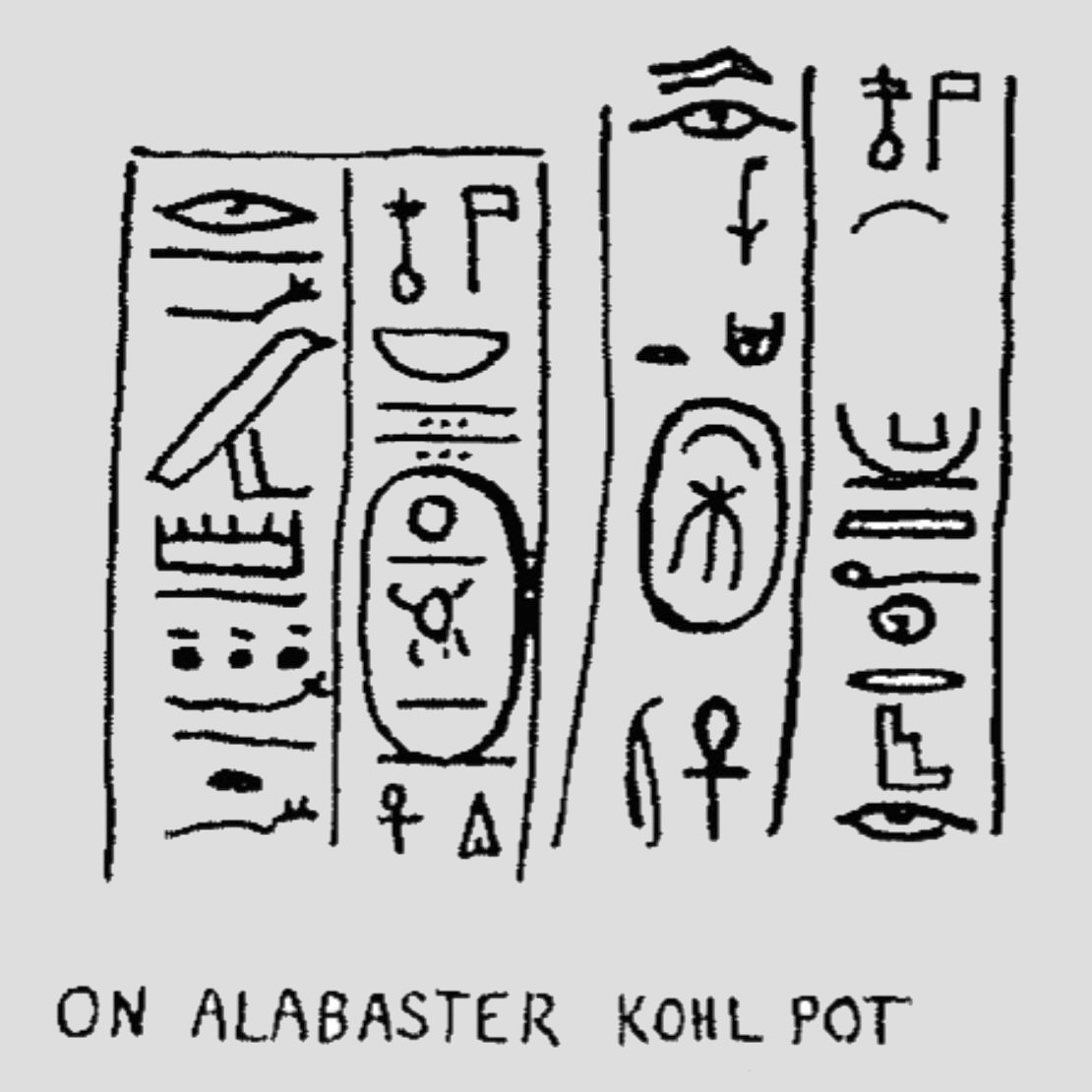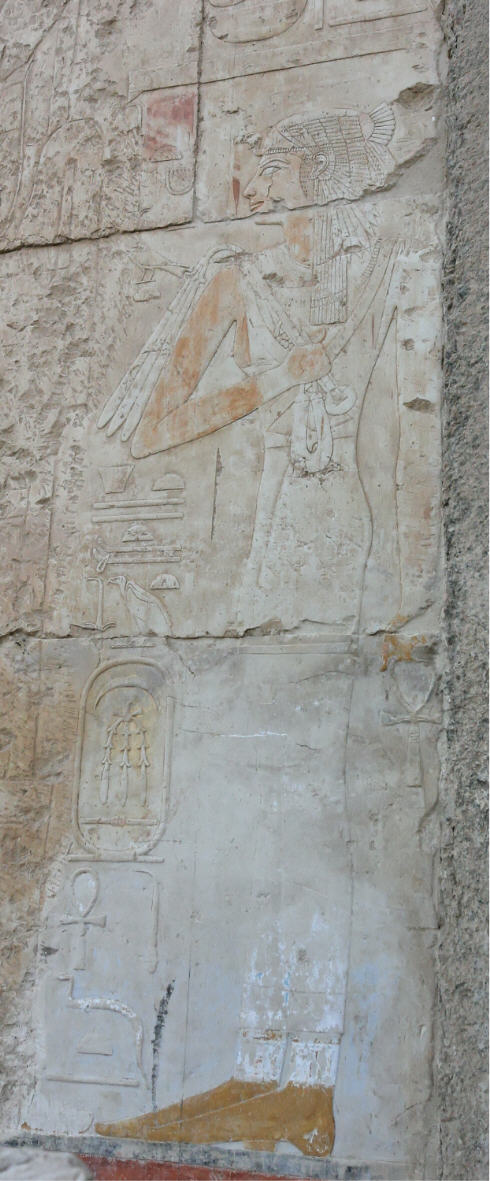|
Maat-ka-Ra Hatshepsut |
last update:
14.06.2009
|
| |
Ahmes
|
|
| The royal wife Ahmose, relief from the temple of Hatshepsut
at Deir el-Bahari, Ceremonial Court, directly south of the entrance to the
main sanctuary of Amun (photo by the author).
|
| Ahmose (= Iahmes [in Dodson, Hilton, Royal Families, P. 137, = Ahmes
B]), her name means "Iah (the moon) is born"; (Sethe, Hatschepsut-Problem, p.
10), was the "Great Royal Wife" of Thutmosis I, the mother of queen Hatshepsut,
and also of a prematurely deceased princess, Neferubiti (also mentioned under the name Achbet-neferu;
Ratie, Reine Hatchepsout, 1979, p.26).
|
| Occasionally it is also discussed whether she was the mother of the
two royal sons Amenmose and Wadjmose (mentioned in Tomb of the Paheri, Elkab; Sethe, Urk. IV, 108 - 110).
According to Ratié (Reine Hatchepsout, 1979, p. 24, who referred thereby to a publication of Daressy)
she was possibly also the mother of further princes named Binpu, Ramose, Nekenkhal, Aahmosis.
|
| According to Troy (Queenship, p. 163, §18.12) only 14 sources
(among them statues, vessels, tomb and temple representations, etc.) have survived recording various
title data of Ahmose. Particularly in the temple scenes of the mortuary temple of
Hatshepsut at DeB Ahmose is presented with the title of a "Great Royal Wife" ,
furthermore as the "Mother of the King" (during the reign of Hatshepsut), and also sporadically with the title
of a " King's Sister" (according to Troy besides DeB also on the stela Berlin 15699; as well as
in the Tomb of the Duauneheh, TT125). On the other hand the title of a "King's Daughter" is missing!
|
| The lineage of queen Ahmose is unknown. However. there were
numerous attempts to connect her with the reigning family of the Ahmosids. |
| In his history of Egypt (History, p. 207) Nicholas Grimal
wrote without further data that after the premature death of the son of Amenhotep I., Amenemhat,
a descendant from a royal side branch of the family, Thutmosis I, strengthened his claims on the
throne by the wedding with a daughter of Amenhotep I called Ahmose.
|
| Christiane Desroches Noblecourt wrote in her history of Hatschepsut (p. 19) about the delivery of
Hatshepsut by Ahmose, "Wife and because they had the same mother, Seniseneb, sister of Thutmosis".
|
| According to Suzanne Ratié (Hatschepsut, 1974, p. 18) the disturbed succession after
the premature death of the sons of Amenhotep I and his queen Ahhotep II had been put in order by the fact
that the royal daughter of the couple, Ahmose, married her half-brother Thutmosis, a the son of
Amenhotep I. and a non-royal concubine called Seniseneb.
|
| According to Bryan (18th Dynasty, p. 231) Vandersleyen regarded Ahmose
as a sister of Thutmosis I since she did not held the title of a "King's Daughter". In his opinion Thutmosis I
married his sister on his accession, thus following the custom of former kings who had married
their sisters to legitimize their accession to the throne.
|
| Sethe assumed (Hatschepsut-Problem, p. 10) that Ahmose was a daughter of Ahmose-Nefertari and,
therefore, a sister of Amenhotep I.
|
| Furthermore, due to a misinterpretation of the statue Louvre N 496 that Ahmose was falsely
identified with Ahmose Nebetta, the "King's Sister and King's Daughter, born by the Great Royal Wife and King's Mother Ahhotep"
(Gitton, Divines of épouses, 1984, p. 16). However, the inscription of the statue dates
it into the end of the reign of Ahmose I. Meanwhile, princess Ahmose Nebetta is identified
as a daughter of queen Ahhotep and king Seqenenre Taâ II (17. Dynasty) thus she lived two
generations before the queen Ahmose.
|
| Finally, there are so far no archaeological records which prove a connection of the "Great Royal Wife"
Ahmose with the family of Amenhotep I - in contrast, there a more indications which make this relationship improbable.
|
| The background for all the assignments were obviously the
problem of the succession to the throne at the end of the reign of Amenhotep I
who died without a successor, and the question why Thutmosis I ascended to the throne.
|
| Ahmose outlived her husband Thutmosis I (Sethe, Hatschepsut
problem, p. 10) and possibly also the reign of his son and successor Thutmosis
II, i.e. she probably died during that reign of her daughter Hatshepsut. This is
based on a Kohl vase found in the Ramesseum (Quibell, J.E., The Ramesseum,
London 1898) with the following inscription: |
"The Good God [Thutmosis I], justified with Osiris,
Osiris, the king's wife Ahmes may she live.
The good God, Lord of the Two Lands, Thutmosis II, given life
he made it as a monument for his father." |

| The mummy of Ahmose is lost and her tomb unknown.
|
| Occasionally, Ahmose has been listed in the literature also with the title of a
"God's Wife of Amun".
|
| The assumption that also the mother of Hatshepsut held the title of a "God's Wife"
is based on the wrong assignment of an ivory hand (Egyptian Museum, Turin, see the following photo)
showing the inscription "God's Wife Ahmose, may she live (= Hmt nTrJaH-ms anx-tj)" to Ahmose,
the mother of Hatshepsut. While Maspero (Maspero, G., RecTrav III, 1982, S. 124)
has mentioned the ivory hand with the comment "..that it is not possible to
say which queen of that name had been the owner of the object in question",
it was already assigned to the wife of Thutmosis I by Petrie (Petrie, W. M.
F., History of Egypt II, 1897, S. 69) a few years later. |
| Later, this wrong assignment was carried forward
for example by Sander Hansen (God's Wife, p. 6) who identified Ahmose-Nebetta as the mother of
Hatshepsut, and also in the corresponding article about Ahmose in the
Lexikon der Ägyptologie (W. Seipel, 1975, Vol. 1, col. 101).
|

| Ivory hand (part of a clapper?) today in the Museo Egizio di
Torino, Catalogue-No 6921 (photo taken from Gitton, Divines épouses, 1984, plate 1,
modified by the author). |
| However, the way of writing the name Ahmose with the upwards opening form of the moon dates
this "God's Wife" completely to the beginning the 18th Dynasty (see also Gitton,
Divines épouses, 1984, p. 25).
According to Gitton this ivory hand probably came from the Theban necropolis - as so many other
objects of the collection Rosellini - but there is no information about the discovery. |
|


